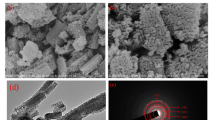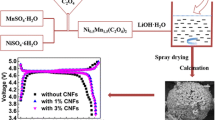Abstract
The two-stage procedure of ball milling and annealing in air represents a prospective method of preparing nanorods of V2O5 with electrochemical properties suitable for the application in lithium-ion batteries. Commercially purchased V2O5 powder is milled in a ball mill as the first step of the synthesis. The as-milled precursor is subsequently annealed in air to produce the morphology of nanorods via solid-state recrystallization. We have recently investigated intermediate stages of the formation of nanorods, and this paper summarizes the synthesis method including the description of the current understanding of the growth mechanism. The obtained V2O5 nanorods have been assessed as an electrode material for both anodes and cathodes of lithium-ion batteries. When used in cathodes, the nanorods demonstrate a better retention of capacity upon cycling than that of the commercially available powder of V2O5. When used in anodes, the performances of nanorods and the reference V2O5 powder are similar to a large extent, which is related to a different operating mechanism of V2O5 in anodes. The experimentally observed capacity of V2O5 nanorods in an anode has stabilized at the level of about 450 mAh/g after few cycles.





Similar content being viewed by others
References
Wang Y, Cao GZ (2006) Chem Mater 18:2787–2804
Wang Y, Cao GZ (2008) Adv Mater 20:2251–2269
Tranchant A, Messina R, Perrichon J (1980) J Electroanal Chem 113:225–232
Liu J, Xia H, Xue DF, Liu L (2009) J Am Chem Soc 131:12086–12087
Glushenkov AM, Stukachev VI, Hassan MF, Kuvshinov GG, Liu HK, Chen Y (2008) Cryst Growth Des 8:3661–3665
Glushenkov AM, Stukachev VI, Hassan MF, Kuvshinov GG, Liu HK, Chen Y (2010) Proceedings of 2009 MRS Spring Meeting, in press
Occhiuzzi M, Cordischi D, Dragone R (2005) J Solid State Chem 178:1551–1558
Delmas C, Cognac-Auradou H, Cocciantelli JM, Menetrier M, Doumerc JP (1994) Solid State Ionics 69:257–264
Ban CN, Chernova NA, Whittingham MS (2009) Electrochem Commun 11:522–525
Poizot P, Laruelle S, Grugeon S, Dupont L, Tarascon JM (2000) Ionics 6:321–330
Chan CK, Peng H, Twesten RD, Jarausch K, Zhang XF, Cui Y (2007) Nano Lett 7:490–495
Poizot P, Laruelle S, Grugeon S, Dupont L, Tarascon JM (2000) Nature 407:496–499
Debart A, Dupont L, Poizot P, Leriche JB, Tarascon JM (2001) J Electrochem Soc 148:A1266–A1274
Anani A, Crouch-Baker S, Huggins RA (1987) J Electrochem Soc 134:3098–3102
Denis S, Baudrin E, Touboul M, Tarascon JM (1997) J Electrochem Soc 144:4099–4109
Leroux F, Gowards GR, Power WP, Nazar LF (1998) Electrochem Solid State Lett 1:255–258
Leroux F, Piffard Y, Ouvrard G, Mansot JL, Guyomard D (1999) Chem Mater 11:2948–2959
Ceder G, Aydinol MK, Kohan AF (1997) Comput Mater Sci 8:161–169
Acknowledgements
The work is supported in part by the Australian Research Council under the Centre of Excellence and Discovery programs. The authors thank the staff of the Electron Microscopy Unit at the Australian National University (Canberra, Australia) for their assistance with SEM and TEM analysis.
Author information
Authors and Affiliations
Corresponding author
Rights and permissions
About this article
Cite this article
Glushenkov, A.M., Hassan, M.F., Stukachev, V.I. et al. Growth of V2O5 nanorods from ball-milled powders and their performance in cathodes and anodes of lithium-ion batteries. J Solid State Electrochem 14, 1841–1846 (2010). https://doi.org/10.1007/s10008-010-1016-x
Received:
Revised:
Accepted:
Published:
Issue Date:
DOI: https://doi.org/10.1007/s10008-010-1016-x




